California is home to nearly 50 types of snakes, more than half of which are found in the Los Padres National Forest. Their diversity is sssssimply astounding. Some are active during the day, others are nocturnal; some are so small that they resemble an overgrown earthworm, while others are five feet long; colors range from black, gray, and brown to yellow, red, and orange, in solid colors, stripes, and fascinating patterns. Some eat insects, some eat small mammals, and some even…eat…other…snakes. Savage!
Most snakes in our region are not venomous and pose no threat to humans. In fact, they provide important services like keeping our rodent populations in check and maintaining a balance in the food web. Snakes often get a bad rap, but in some cultures, snakes are viewed as good fortune and in others, the snake created the world. If you need a rattlesnake removed from your property, there’s likely someone near you who will do it humanely and for free. Check out this directory of free snake relocation services.
While some snakes are common, others are under serious threat and even face extinction. We don’t necessarily have to love snakes (edit: YES WE DO!), but we can at least respect their right to exist, appreciate their role in the circle of life, and marvel at what fascinating creatures they are.
Photos © Gary Nafis at californiaherps.org used with permission under a creative commons license. Additional photos © Bryant Baker/Los Padres ForestWatch.
Rubber boa (Charina bottae)
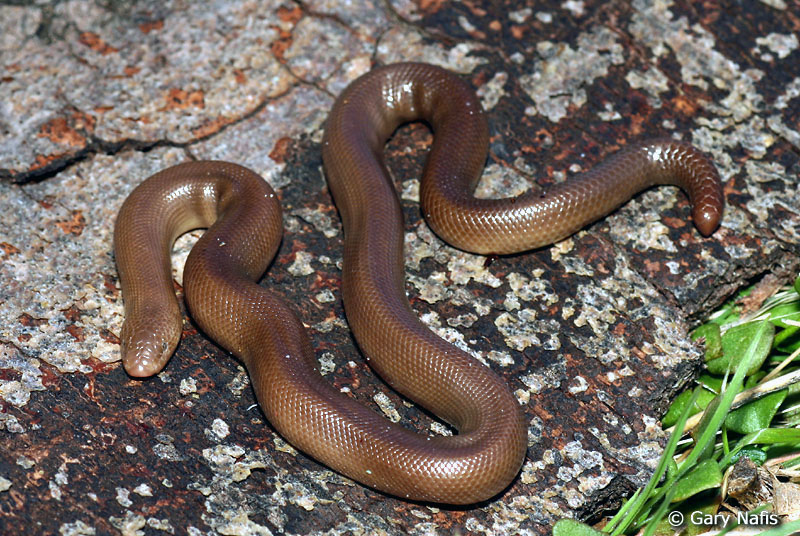
Heads or tails? Rubber boas have short, blunt tails that are about the same size as their heads. When threatened, the rubber boa curls up, tucks its head into its body, and sticks up its tail to fool predators. They can live up to 60 years in the wild and are seldom seen because they are nocturnal and burrow under ground. Our region has two types of rubber boas: the Northern rubber boa, which is found throughout Northern California, Big Sur, and the SIerra Nevada; and the Southern rubber boa, which is considered threatened by the State of California. The two subspecies intermix in the area around Mt. Pinos, where forests and woodlands with large downed logs, thick leaf litter, and rock outcrops provide optimal habitat. Several proposed logging and vegetation clearing projects could destroy these fragile habitats and reduce soil moisture that rubber boas need to survive.
California glossy snake (Arizona elegans occidentalis)
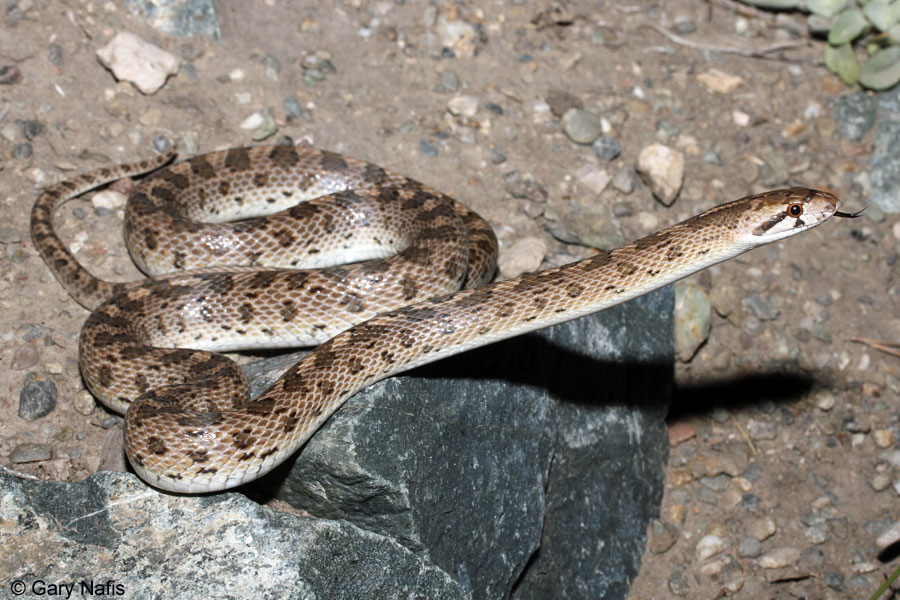
This nocturnal snake is found in chaparral, rocky washes, and grasslands from the Bay Area south to Baja California, but is absent from the central coast. It is found in more inland areas of Los Padres National Forest, including the San Emigdio Mountains, the Cuyama Valley, the Carrizo Plain, and the La Panza Range. It grows to 3-4 feet long, and is considered a “Species of Special Concern” in California based on its significant declines in population size and range over the past several decades due to agricultural, commercial, and residential development
Western yellow-bellied racer (Coluber constrictor mormon)
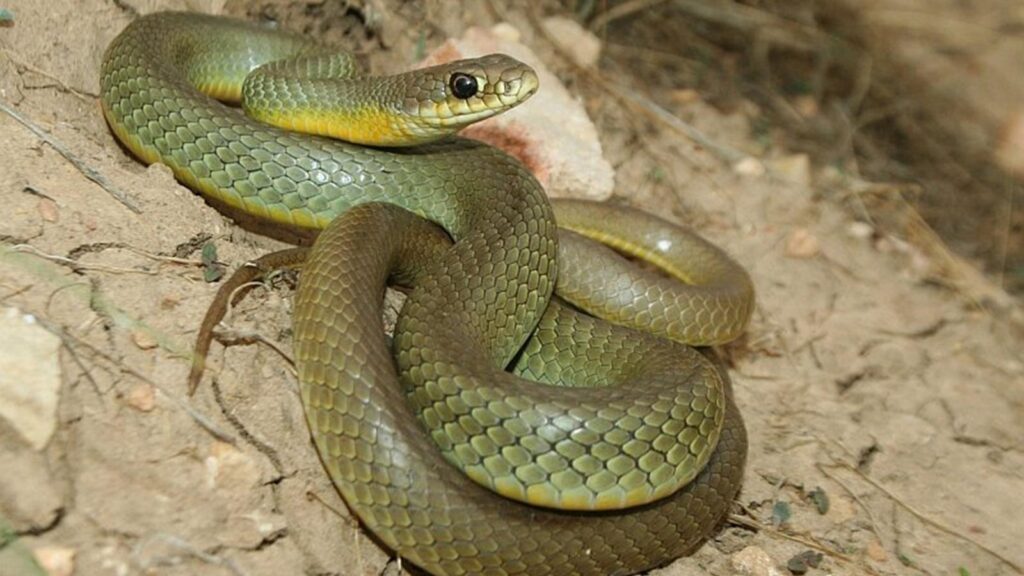
This yellow-bellied fella is found in many areas of Los Padres National Forest, as well as throughout California and the West. It has a distinctive yellow belly with a long, thin tail and grows to about three feet long. Racers hold their heads and necks above the ground when hunting and are fast, aggressive snakes, though they are nonvenomous and harmless to humans.
Coachwhip (Coluber flagellum)
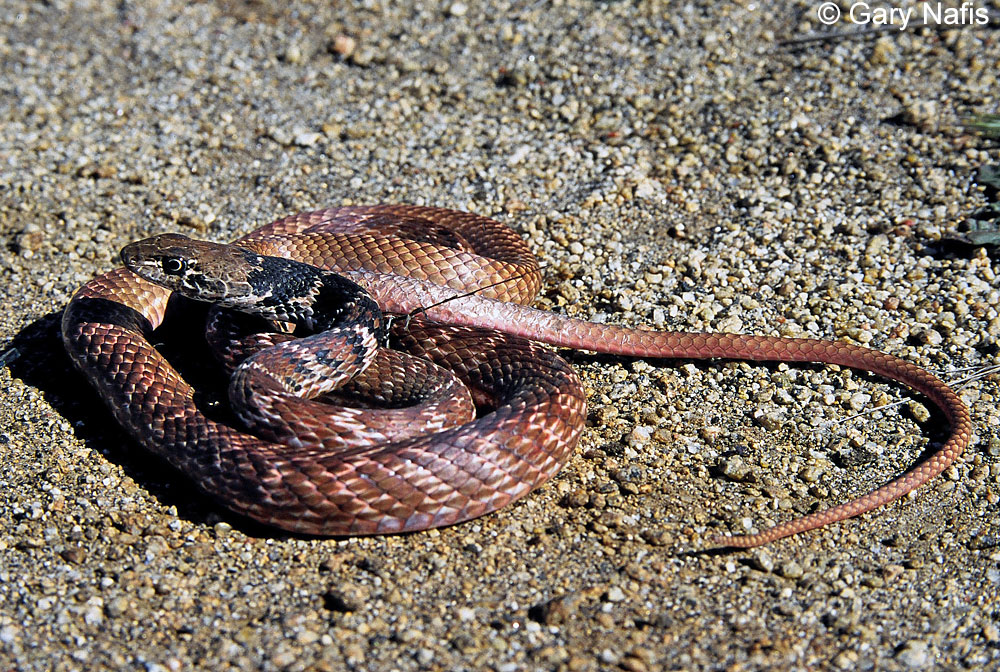
The scales on this long and slender snake appear braided like a whip, giving this species its name. They can grow up to five feet long, making coachwhips the second longest snakes in California. Three subspecies of coachwhip occur in California, including the red coachwhip (found in Ventura County south) and the San Joaquin coachwhip (found in the Cuyama Valley, eastern San Luis Obispo County, the San Joaquin Valley, and points north). Coachwhips are active during the day and move very quickly.
California striped racer (Coluber lateralis lateralis)
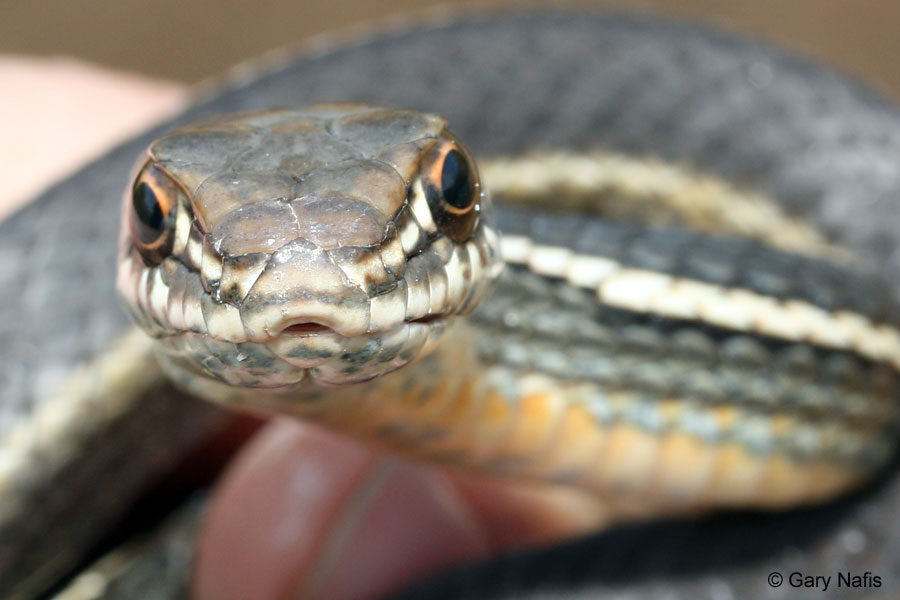
The striped racer–also known as a whipsnake–is found throughout California and the Los Padres National Forest. It has a pale yellow stripe along each side of its body, and grows up to four feet long. These quick snakes are active during the day, and show a strong preference for eating lizards, which are swallowed alive. In early mornings, they may move into the top of shrubs to gain access to sunlight.
Common sharp-tailed snake (Contia tenuis)

One of the smaller snakes in California, the Common sharp-tailed snake is less than a foot long with a beautiful pattern featuring reddish brown stripes along its body and black and white stripes on its underbelly. The sharp-tailed snake has a pointy tail and is found in damp forest habitats with Douglas-fir and redwoods. Found primarily in Northern California, the sharp-tailed snake slithers as far south as Big Sur and San Luis Obispo County.
Ring-necked snake (Diadophis punctatus)
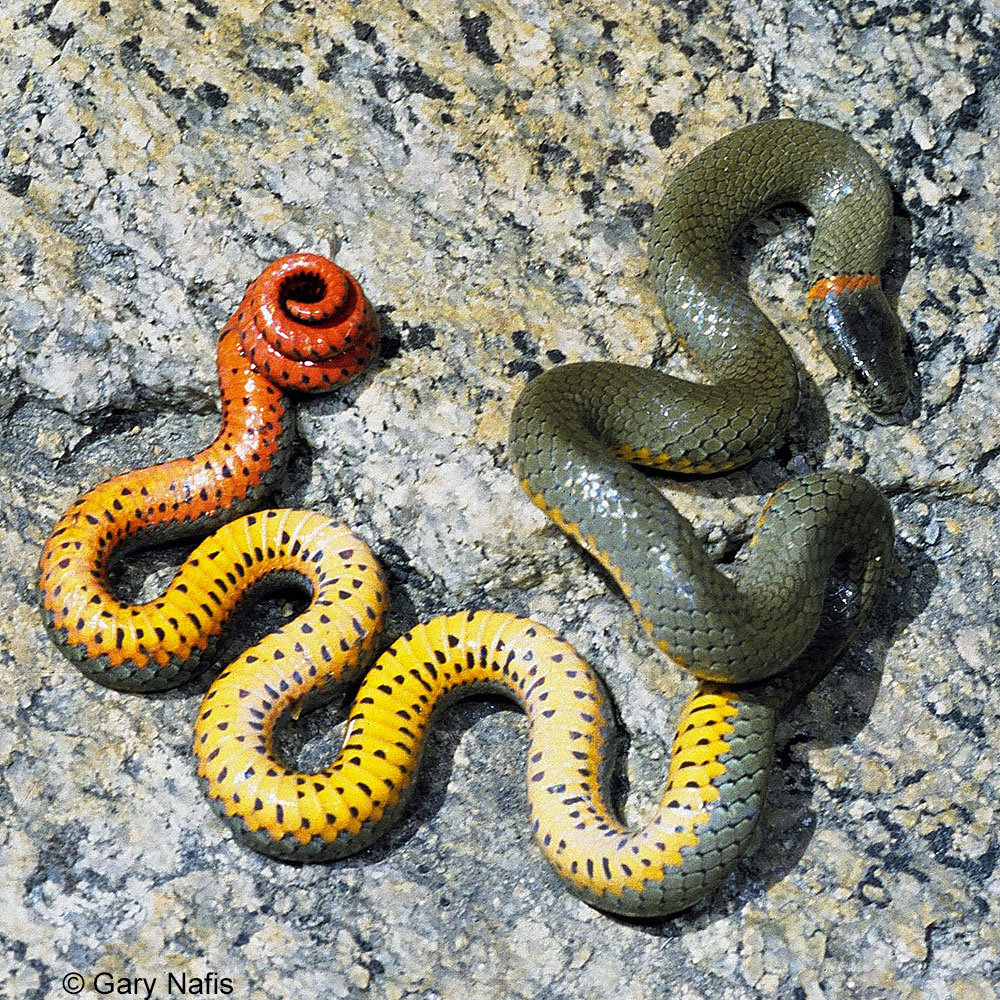
The bright orange underside of the ring-necked snake is a spectacle to behold. A narrow orange band around the neck distinguishes this snake from other species. California has seven subspecies of ring-necks including two in Los Padres National Forest. The San Bernardino ring-necked snake is found from Ventura County south, and the Monterey ring-necked snake slinks amidst Santa Barbara, San Luis Obispo, and Monterey counties. When disturbed, ring-necks coil their tails like a corkscrew, and they produce a mild venom. While not harmful to humans, bites should be avoided. The U.S. Forest Service considers the San Bernardino ring-necked snake to be a sensitive species.
Nightsnake (Hypsiglena ochrorhyncha)
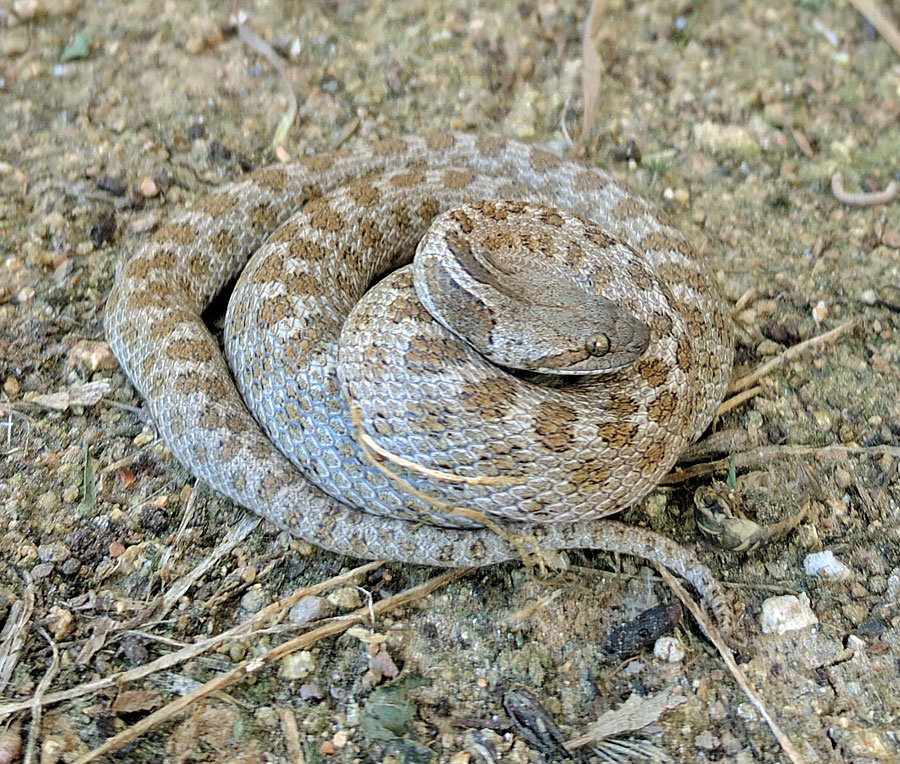
The nocturnal nightsnake may produce a mild venom, but it’s not harmful to humans. The San Diego nightsnake is found in Santa Barbara and Ventura counties and points south, while the California nightsnake is found in San Luis Obispo and Monterey counties and points north. Nightsnakes are light brown with narrow, flat heads and grow to 1-2 feet long.
Coast mountain kingsnake (Lampropeltis multifasciata)
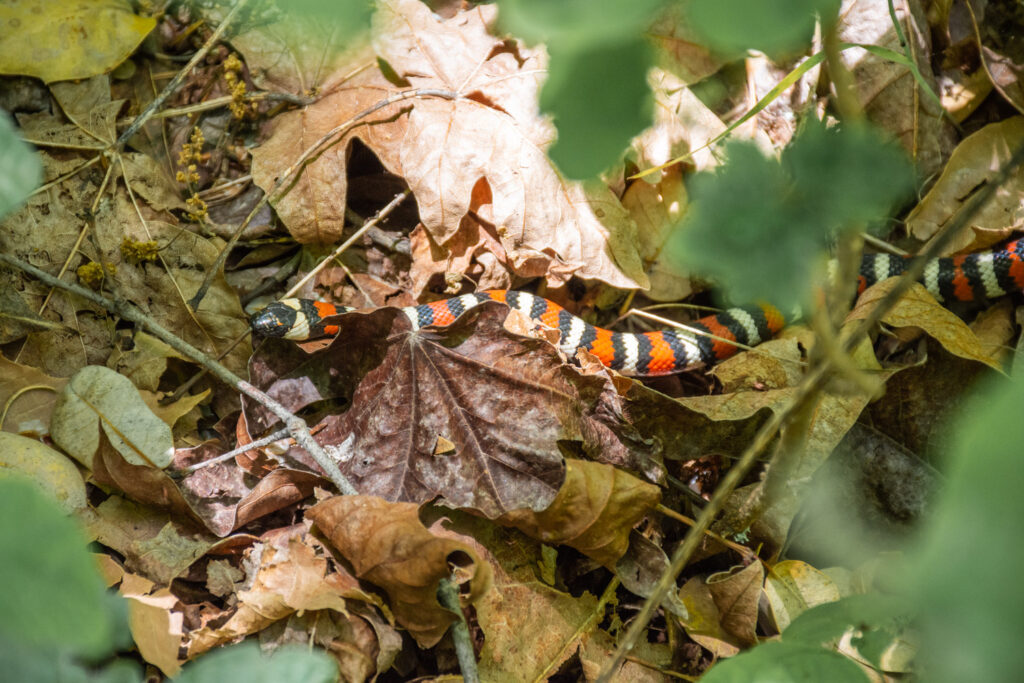
Snake royalty for sure, coast mountain kingsnakes can eat other snakes including rattlesnakes and are immune to rattlesnake venom. Males engage in lively combat during the breeding season, or when they are competing for food or territory. As the battle ensues, each kingsnake tries to get on top of the other to dominate his rival, with the other snake crawling away or assuming a submissive position. The king snake has alternating bands of black, red, and white and grow up to four feet long. Their coloration can be confused with the highly venomous coral snake found in other parts of the country (“red on black, a friend of Jack; red on yellow, kill a fellow”). Kingsnakes kill their prey by constriction (squeezing). They are the strongest constrictors proportionate to body size of any snake. There are two species of kingsnake in California. The coast mountain kingsnake is found between Monterey and Baja California, and the California mountain kingsnake is found in the Sierra Nevada and the mountains of northern California, as well as further north into Oregon and Washington.
Gophersnake (Pituophis catenifer)
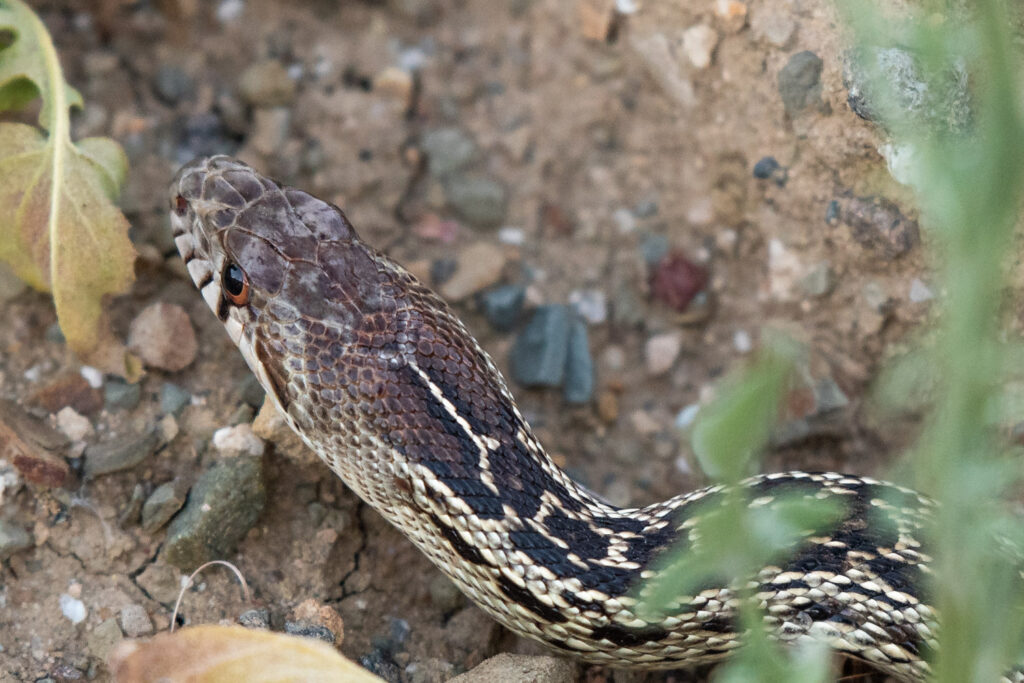
Gophersnakes are one of the most commonly seen snakes in California, with five subspecies in California and two in Los Padres National Forest. The San Diego gophersnake is found nearer the coast, from San Luis Obispo to San Diego, and the Pacific gophersnake is found in interior regions of San Luis Obispo and is widespread throughout Monterey County and most parts of the state north of there. They are 4-5 feet long and frequently seen in suburban backyards, keeping rodent populations in check (in addition to gophers, their favorite meals are moles, rabbits, and mice). When threatened, it can inflate its body, flatten its head, hiss loudly, and shake its tail to mimic a rattlesnake, and while it may strike, it is not venemous. Unfortunately, this harmless and beneficial snake is very often killed out of fear that it is dangerous or that it is a rattlesnake (rattlesnakes have a wider head and dull scales, while gophersnakes have a narrower head, shiny scales, and round pupils unlike rattlesnakes). Next time you see one, be sure to thank it for its services!
Gartersnake (Thamnophis spp.)
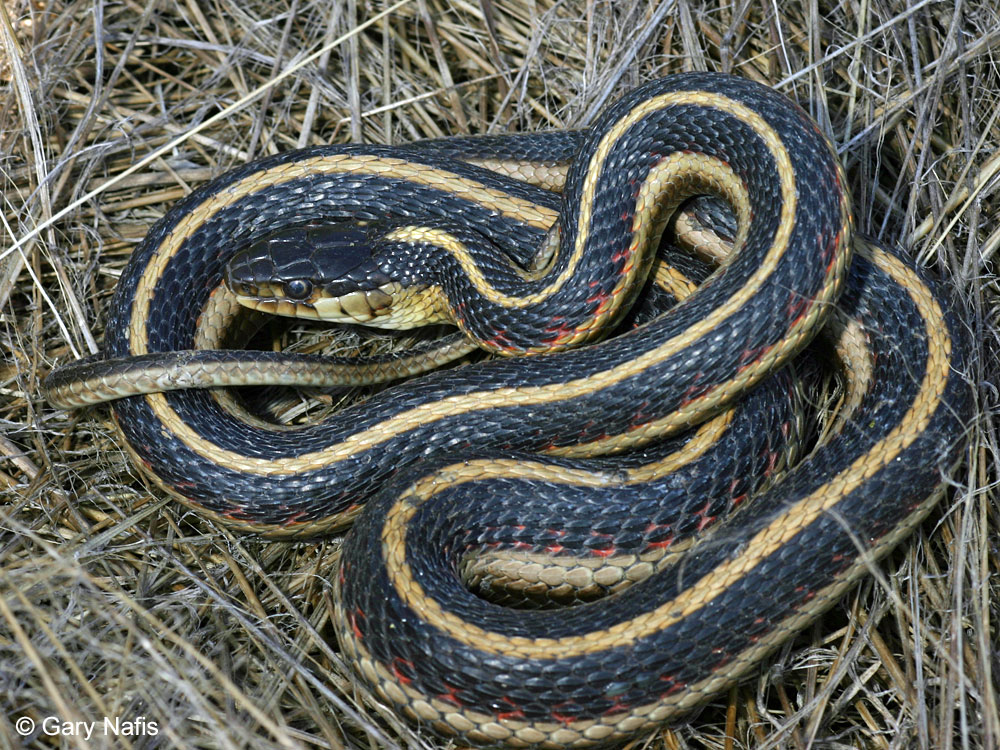
There are 14 types of gartersnakes in California, and five of them are found in the Los Padres National Forest. The valley gartersnake (pictured above) is found from Ventura County northward; the coast gartnersnake is found from Santa Barbara County northward; the Diablo Range gartersnake is found in coastal mountains from Santa Barbara County to Big Sur and points north; the Sierra gartersnake is found in the Sierra Nevada, the Tehachapis, and a narrow band along the San Emigdio Mountains; and the rare two-striped gartersnake is found in coastal areas from Monterey south. While most gartersnakes are common, the two-striped gartersnake is considered sensitive by the U.S. Forest Service and a “species of concern” by the State of California. It is among the most aquatic of gartersnakes, primarily spending its time in or near water.
Long considered non-venomous, discoveries in the early 2000s revealed that gartersnakes produce a mild venom that can be harmful to small prey. It is not considered dangerous to most humans, although a bite may cause slight irritation and swelling around the puncture wound. Gartersnakes can eat Pacific newts, which are deadly poisonous to most predators. When gartersnakes eat newts, they retain the deadly neurotoxin found in the skin of news for several weeks, making the snakes poisonous to other animals sch as birds or mammals that might eat them.
Western rattlesnake (Crotalus oreganus)
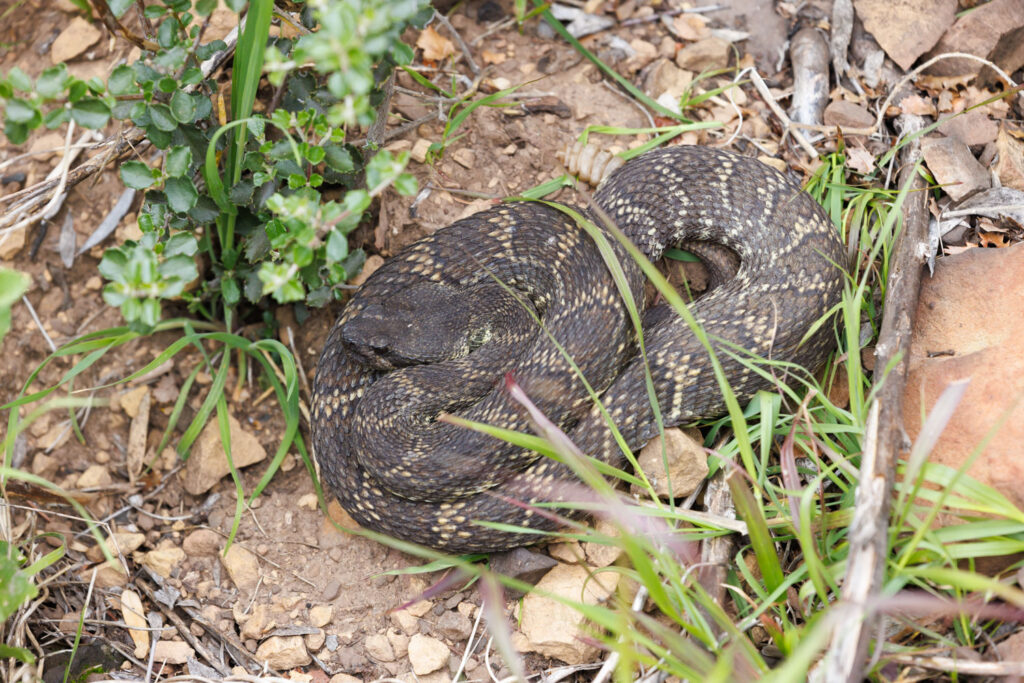
Rattlesnakes are important members of the natural community that deserve distance and respect. They won’t attack, but they will defend themselves if disturbed or cornered. Often they will give fair warning with a loud, buzzing rattle of their tail. California has ten different types of rattlesnakes, with two of them found in Los Padres National Forest. The southern Pacific rattlesnake occurs in the coastal mountains and valleys from Santa Barbara County south, while the northern Pacific rattlesnake is found from San Luis Obispo County northward. All rattlesnakes in California have a blotched pattern on the back and a triangular-shaped head that is much wider than its body. Their bite is venomous and can be deadly to humans, so give them space, be aware of where you step, and keep your pup on a leash.
Long-nosed snake (Rhinocheilus lecontei)
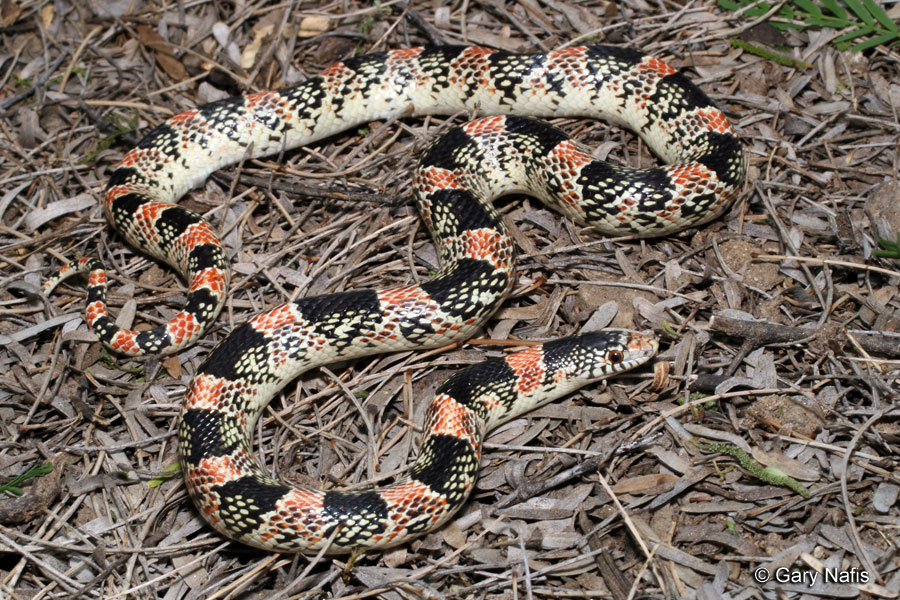
The long-nosed snake has–get ready for it–a long, pointed snout! It’s found in southern and central California, including in the San Emigdio Mountains and the La Panza Range in the Los Padres National Forest. It’s also found in several other states and Mexico. Long-nosed snakes can grow up to three feet long and have a distinctive red, black, and white pattern. When threatened, it can excrete blood through its body.
Patch-nosed snake (Salvadora hexalepis)

There are three types of patch-nosed snakes in California, two of which are found in Los Padres National Forest. The Mohave patch-nosed snake occurs primarily in the Mojave Desert but may be found in the San Emigdio Mountains. The coast patch-nosed snake is more common in our area, found slithering throughout Santa Barbara, Ventura, and a portion of San Luis Obispo counties as well as other areas in southern California. What’s so patchy about its nose, you might wonder? It has an enlarged rostral (the scale over the tip of the snout). This “patch” is thought to be useful in excavating buried lizard eggs, and may also be used to dig into underground burrows. It can burrow into loose soil, and its acute vision allows this snake to escape quickly when threatened. The coast patch-nosed snake is considered a “species of special concern” by the State of California due to destruction of its habitat and decline in numbers.
Western black-headed snake (Tantilla planiceps)
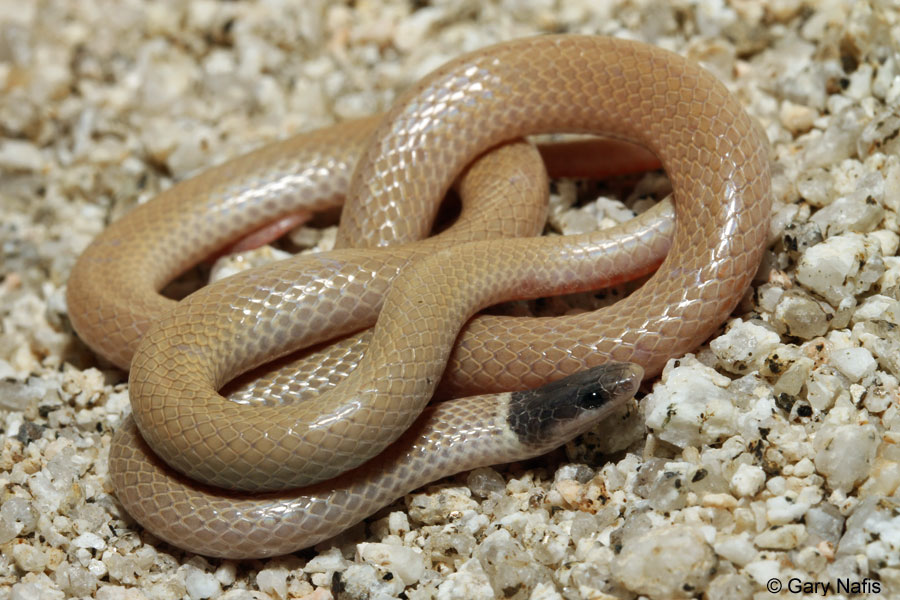
Here we have one of the smallest snakes in California, with most measuring less than one foot long. The western black-headed snake is found along the coast of California, including the mountains of Santa Barbara and Ventura counties. Their body color is brownish or beige and unmarked, with a reddish underside. The top of its head is indeed black (or dark brown), with a faint light collar.
California lyresnake (Trimorphodon lyrophanes)
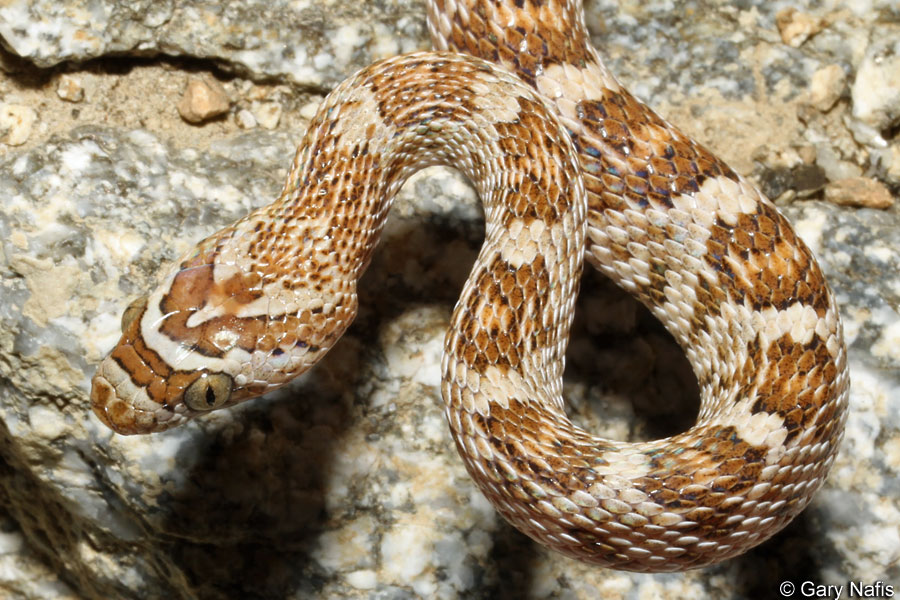
We love a good snake name, and the lyresnake takes top prize in that contest, so named because of the small U-shaped pattern on its head that resembles an ancient Greek harp. The California lyresnake is nocturnal and a great climber that is commonly found in rocky locations in southern California, mainly from Ventura County southward. Lyresnakes may produce a mild venom that does not typically cause death or serious illness or injury in most humans, but its bite should still be avoided.
Southwestern threadsnake (Rena humilis humilis)
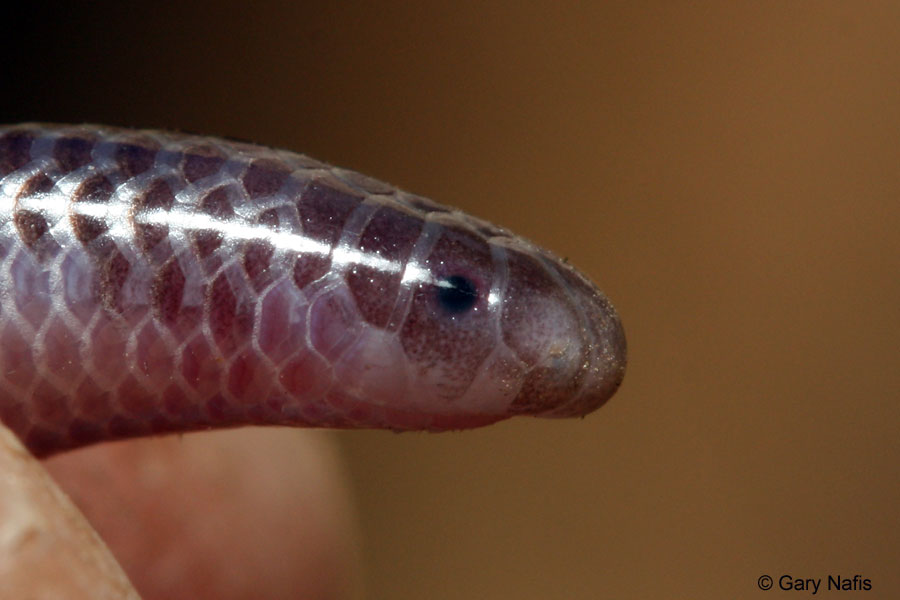
“Who you callin’ an earthworm?” Last and…well, most certainly least, the threadsnake is one of the world’s smallest snakes, measuring only several inches long. It’s also very thin, with a blunt head and tail tipped with a small spine. This snake is nocturnal, and its eyes are dark spots that can detect light but are otherwise nonfunctional. It has little need for sight, since it is nocturnal and lives underground, sometimes as deep as 50-60 feet where the soil is loose enough. They feed on ants and termites. This little guy is found from Santa Barbara and Ventura counties and points south.






